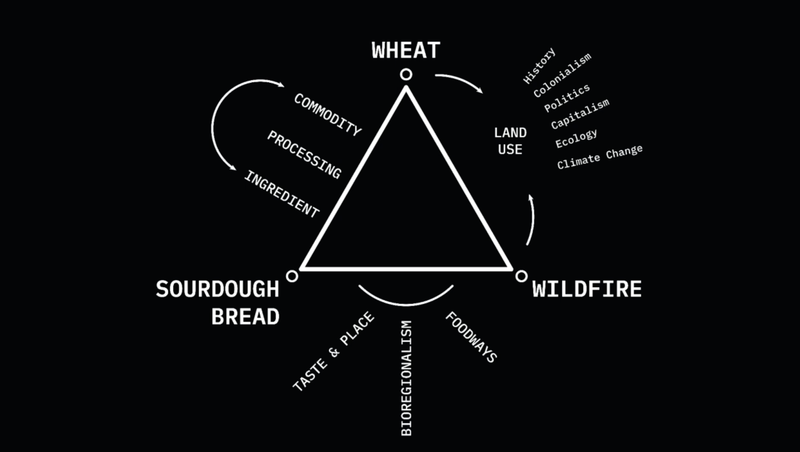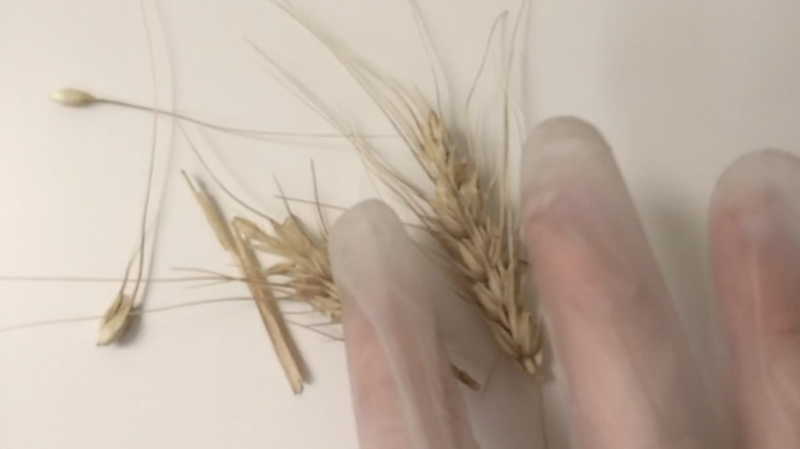Firebreak Banana Bread: An Edible Timeline
I. Introduction
This is a recipe for bread. A recipe is a form of time travel you can taste. The primary ingredients for this recipe are wheat, bananas, and treenuts. Each ingredient represents a way of eating and being: one each for yesterday, today, and tomorrow.
As you cook and eat this bread, you are invited to position yourself. You exist on a specific point on the surface of the Earth at a particular moment in time. Unless you are reading and eating in outer space, in which case, wow! We did not think that many humans would be reading or eating off planet!
As you eat this bread, visualize the geometry of time in the place where your feet touch the Earth. Is time a line, a circle, a web or a knotted mess? Depending on your location, the future may taste more or less like the past or like nothing you have ever tasted before.
Firebreak Banana Bread is a transitional recipe. It sits in the cracks between the legacy of the globalized commodity food system and the ongoing climate emergency. It has three main ingredients. An annual grass, a perennial herb and a perennial tree.
Slow food, slower food, slowest food.
This recipe takes the form of bread because bread is easy to transport and circulate. It can be easily grasped in one’s hands and in one’s mind. Bread aspires to be the same each day, year round. Bread is an epiousios recipe. In the future bread may be a much less useful metaphor and recipe, because it seeks to integrate and minimize differences between and amongst ingredients. Bread does not give the eater much information about the organisms and environments from which it came. In the future we will likely prefer ingredients and culinary forms that are less uniform, fungible, and efficient. In the future we will prefer culinary forms that provide information about the organisms and environments from which they came.
A salad might be a more appropriate form to symbolize resilient regional food futures. Or thali, or any culinary form where diversity and abundance of DIFFERENCE—rather than uniformity and abundance of AMOUNT—is put on display.
A salad is best prepared close to where it is grown.
A salad doesn’t travel well.
A salad puts its seasonal and biodiverse qualities on display. Variation is its reason for being. A salad is of its time and place.
A salad provides #FoodSecurityThroughObscurity and seeks to maximize the #BiodiversityOfTheKitchen.
...
But for now—as we are broad-casting this message to people we can’t see, and whose locations we don’t know—bread will have to do.
II. Ingredients
WHEAT
Firebreak Banana Bread is a recipe haunted by the proliferation of wheat monocultures and the spread of wildfires. Climate change is increasing the number and severity of wildfires. In addition to burning croplands, wildfires can impact the taste and health of crops—such as wine grapes and wheat—at a distance, via smoke taint.

To test your wheat for smoke taint, open the bag or container of wheat and smell deeply. If you notice a strong smoky smell or other Commercially Objectionable Foreign Odor (COFO), you may want to speak with your grain grower or miller about wildfires in the area or other ecological pressures on continued wheat growing.

Firebreak Banana Bread is a stopgap recipe between the Wildfire Loaf of the 2020’s and the #FoodForestFantasies that will take a decade or more to cultivate and maintain.
Food forestry is a system of agriculture that is resilient to ecological shocks including floods, droughts and fires, but there is a mismatch between the speed needed to address the climate emergency and the patience needed to cultivate adaptive agroecosystems like food forests.

Wheat consumption and monoculture farming will need to be wound down, especially in landscapes where they are ecologically maladapted. Moving beyond commodity crops and grains will be hard, because so much has been invested and reproduced in terms of infrastructure, habits, technology, and culture. This recipe still retains some amount of wheat, but much of its mass is substituted with fire break bananas.
BANANA
One medium-term response to increased wildfires is the planting of green fire breaks. The Edible Fire Breaks project proposes to strategically plant crops—in the form of fire-resistant bananas—“around the perimeter of urban areas to discourage the encroachment of fires into areas where people live.”
This kind of multi-use farming reduces the rate of fire spread and creates a highly charged symbolic environmental indicator that can be seen and understood in real-time. It moves farming closer to urban communities, and accepts that some crops may burn and will need to be replanted and that communities may need to conduct planned relocations.
When acquiring bananas for Firebreak Banana Bread, it is preferable if you can source fruits that are grown as green fire breaks. If no fire break bananas are available near you, you could think about initiating a green fire break planting in your community.
TREENUT
Source your treenuts (walnuts, hazelnuts, or other species) from a food forest. Food forestry is a system of agriculture that uses perennial plants and is optimized for resiliency rather than efficiency. Food forests often contain guilds of plants with a treenut at the center.
With our Food Forest Fantasies, we are planting combinations of slow-growing ingredients and preparing menus for future generations to taste. We hope that our experimental forest farms can survive the uncertain but extreme hydrological, agricultural, and climatic conditions of the coming decades.
No one knows how high the water will rise or how long the droughts will last, but it seems certain that the culinary world we inhabit today is coming to an end. Food Forest Fantasies is a form of edible eschatology: eating at the end of a world while preparing for An Other.
III. Recipe instructions
INGREDIENTS
400 ml wheat flour (smell for smoke taint. See above under WHEAT)
3 bananas, sourced from your local green fire break farm
120 ml chopped food forest treenuts
—
75 ml fat (oil, butter, or other)
100 ml sweet (honey, maple syrup, finely chopped dates, or sugar)
18 ml baking powder
2.5 ml baking soda
Pinch of salt
INSTRUCTIONS
In a medium bowl mash the bananas. Add the fat and sweet and combine. Add the dry ingredients and combine but don’t overmix. Tip in chopped treenuts. Pour batter in a greased pan. Bake at 200 C (gas mark 6) for 45-60 minutes.
This text is featured as part of FoAM's Anarchive
Created: 10 Jan 2023 / Updated: 22 Feb 2023


